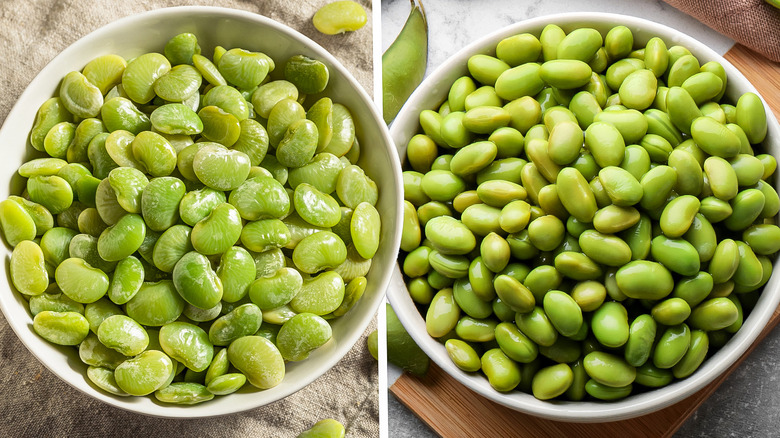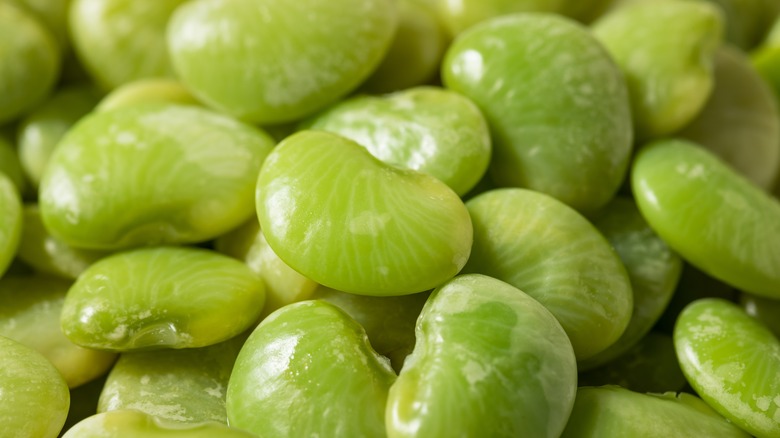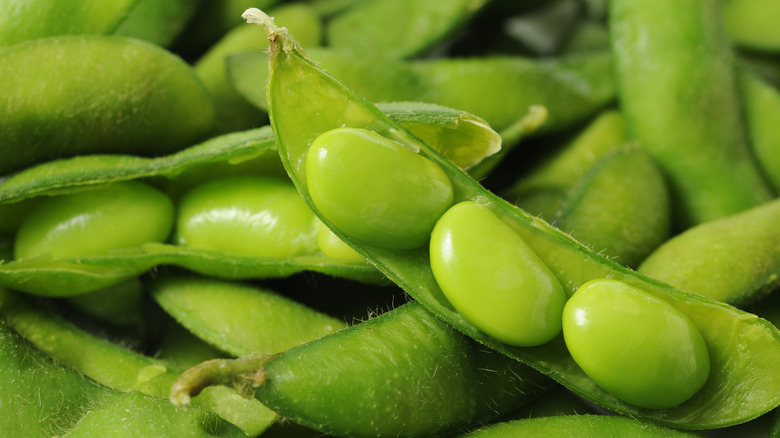Lima Beans Vs Edamame: Which Is Better For Topping Your Salads
At a glance, lima beans and edamame look quite similar, but there are differences to consider if you want to use either bean variety as ingredients to elevate your salad in addition to nuts or dried fruits. Both legumes provide distinct flavor, texture, and nutrients so the best choice really comes down to what kind of salad you are making to match the flavor profiles. Then there's the varying prep work involved before you can take the first bite of your salad.
There are some subtle similarities between lima beans and edamame. The first, and perhaps most obvious commonality is their similar green color which might be important if you like a pop of brightness on top of a salad. When it comes to certain vitamins and nutrients, both options contain similar levels of iron and vitamin E if you need more of either in your diet. But other nutritional components vary between the two beans, with edamame having twice as much calcium. The calorie contents are similar if you are counting the calories that go into your salad, and both can be boiled or steamed in around five minutes for easy preparation. So let's look a little deeper into the differences and which salads each one pairs well with.
Add a creamy contrast to salad with lima beans
Lima beans are rooted in Peru – as the name that corresponds with the country's capital suggests, and are popular in the southern United States these days. And yes, they are also called butter beans. The inside of the beans obtain a creamy texture when cooked so they make an ideal salad topping if you want a contrast with ingredients that add crunch to your salad like croutons or nuts. A bite of a lima bean is rather mild-tasting and somewhat buttery, so it's the best option between the two beans to add fiber and vitamin C to the salad without the flavor taking over the bowl. Consider lima beans if you are using other ingredients that have bolder flavors such as peppers.
A popular use for lima beans is in a bean salad with red onions, peppers, and fresh herbs. For this option, boil the beans so they are creamy but still firm. You might consider trying Tasting Table's fresh herb lima bean salad recipe. To use lima beans as a topping on a traditional green salad with other vegetables, simply boil, steam, or even sauté the legumes. You can also roast lima beans in the oven for up to 45 minutes to make them crunchier if you want to skip the croutons in a salad.
Edamame give a boost of protein to salads
If you don't know, edamame are soybeans before they fully mature. The beans are popular in Japan, and you might have eaten them straight out of the shell with a little salt as an appetizer at your favorite Asian eatery. Compared to lima beans, edamame pack protein making them an ideal choice if you want to skip meat in your salad. As for texture, edamame beans can be firmer than lima beans although the insides can still be creamy so use these in salads when you need ingredients to hold up to a rich vinaigrette or creamy dressing. Edamame have a similar flavor to peas with nutty notes, so consider this swap if you like regular peas in your salad.
There are different ways to prepare the legume so consider these tips for cooking edamame before you toss them into your salad. You can boil, steam, sear, and even microwave edamame to use as a salad ingredient. You can also roast them to make a crunchy addition to your next salad. Just be sure to remove the beans from the shell before adding them. Like lima beans, edamame are popular in bean salads and pair nicely with other Asian ingredients like sesame seeds, sesame dressing, sriracha, and cabbage. Add a bunch to Tasting Table's seaweed salad or napa cabbage salad recipes for a tasty protein-packed topping.


